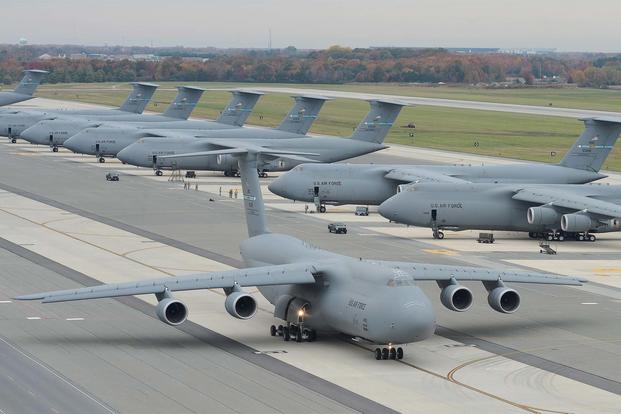After intense scrutiny on parts costs, the U.S. Air Force is 3D printing toilet seat covers for its cargo airlift planes instead of spending $10,000 to replace them.
"We now produce the latrine cover for the C-5 [Galaxy] using 3D printing," service spokeswoman Ann Stefanek told Military.com in an email Wednesday. "Using this new process allows us to make parts that are no longer in production and is driving major cost savings."
The news comes after Sen. Chuck Grassley, a Republican from Iowa, demanded that the Defense Department's Inspector General's office investigate why the service was spending so much to purchase individual seat covers for the planes.
Grassley last month queried the department on the "egregious and wasteful" spending after Assistant Secretary of the Air Force for Acquisition, Technology and Logistics Will Roper told DefenseOne in an interview the service was shelling out thousands of dollars each time to replace broken seat covers instead of using 3D printing for a quick and less expensive fix.
Related content:
- $10,000 Toilet Seats and Data Rights: The Air Force's New Dilemma
- Air Force Creates Office to Help It Shake Up Acquisition Process
- New Air Force Acquisitions Chief Aims to Rid F-35 of Software Glitches
"You'll think, 'There's no way it costs that,' " Roper told DefenseOne in May. "No, it doesn't, but you're asking a company to produce it and they're [busy] producing something else," he said.
Lockheed Martin Corp. originally produced the part, but ceased production in 2001.
It was originally reported the seat cover in question was for the C-17 Globemaster III. The Air Force clarified Roper was talking about the C-5.
The service also said the specific part was a C-5 "cover-center wall, troop compartment latrine," a 1980s-era part required to protect the aircraft from corrosion damage in the latrine area caused by urine.
Roper was making the case that the Air Force could and should do more with 3D printed parts.
But because the service doesn't inherently own the rights to manufacture specific components -- nor does it have a surefire way of dealing with who owns the data rights or intellectual property to manufacture the parts -- taxpayers are paying a high price as a result, he said.
Stefanek clarified that Roper had used the toilet seat cover as an example of why the service should turn to additive manufacturing for cost savings.
However, intellectual property rights were never the issue in this particular case, she said.
"It was because of diminishing manufacturing resources," Stefanek said. "Nobody had the plans for it."
After Lockheed Martin stopped production, "small business had to backward engineer it. And the prices rose over time," she said.
Grassley found the spending wasteful.
"If Dr. Roper's information is accurate, I would be very discouraged, indeed. It would tell me that we have not made much progress in the war on waste. In fact, it would tell me that we may be losing ground," Grassley said in his letter to the Defense Department.
"Moreover, the DoD should view this revelation with alarm, because it could be used to cut the defense budget -- as it was in the 1980's. It seems to me that there is no way to justify a $10,000 price tag for a toilet seat lid. It's just not credible. It needs scrutiny," the senator said.
Roper said 3D printing would lower the cost to $300 per part.
"Additive manufacturing is a game changer for us -- it is perfect for creating small, complex parts that can be printed when and where required at a much lower cost," Stefanek said Wednesday.
-- Oriana Pawlyk can be reached at oriana.pawlyk@military.com. Follow her on Twitter at @Oriana0214.










